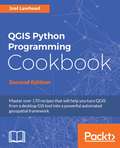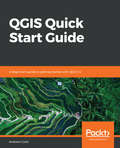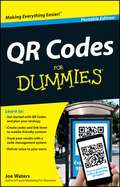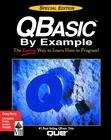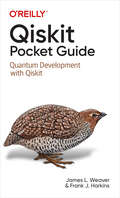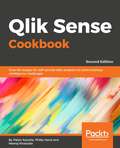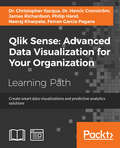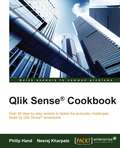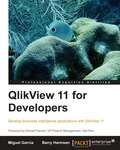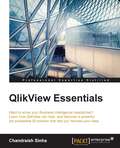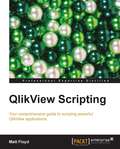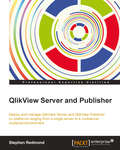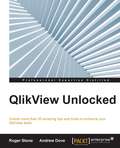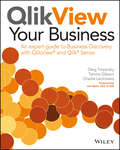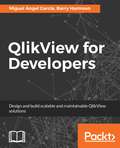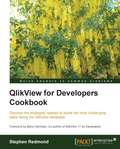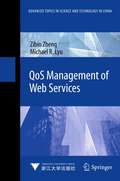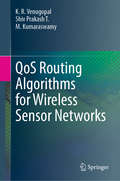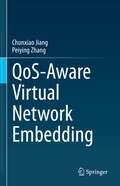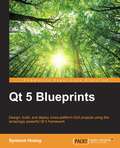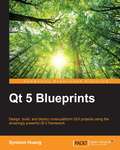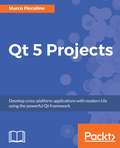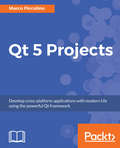- Table View
- List View
QGIS Python Programming Cookbook - Second Edition
by Joel LawheadMaster over 170 recipes that will help you turn QGIS from a desktop GIS tool into a powerful automated geospatial framework About This Book • Delve into the undocumented features of the QGIS API • Get a set of user-friendly recipes that can automate entire geospatial workflows by connecting Python GIS building blocks into comprehensive processes • This book has a complete code upgrade to QGIS 2.18 and 30 new, valuable recipes Who This Book Is For This book is for geospatial analysts who want to learn more about automating everyday GIS tasks as well as programmers responsible for building GIS applications. The short, reusable recipes make concepts easy to understand and combine so you can build larger applications that are easy to maintain. What You Will Learn • Use Python and QGIS to produce captivating GIS visualizations and build complex map layouts • Find out how to effectively use the poorly-documented and undocumented features of the QGIS Python API • Automate entire geospatial workflows by connecting Python GIS building blocks into comprehensive processes • Create, import, and edit geospatial data on disk or in-memory • Change QGIS settings programmatically to control default behavior • Automatically generate PDF map books • Build dynamic forms for field input In Detail QGIS is a desktop geographic information system that facilitates data viewing, editing, and analysis. Paired with the most efficient scripting language—Python, we can write effective scripts that extend the core functionality of QGIS. Based on version QGIS 2.18, this book will teach you how to write Python code that works with spatial data to automate geoprocessing tasks in QGIS. It will cover topics such as querying and editing vector data and using raster data. You will also learn to create, edit, and optimize a vector layer for faster queries, reproject a vector layer, reduce the number of vertices in a vector layer without losing critical data, and convert a raster to a vector. Following this, you will work through recipes that will help you compose static maps, create heavily customized maps, and add specialized labels and annotations. As well as this, we'll also share a few tips and tricks based on different aspects of QGIS. Style and approach This book follows a recipe-based problem-solution approach to address and dispel challenges faced when implementing and using QGIS on a regular basis.
QGIS Quick Start Guide: A beginner's guide to getting started with QGIS 3.4
by Andrew CuttsStep through loading GIS data, creating GIS data, styling GIS and making maps with QGIS following a simple narrative that will allow you to build confidence as you progress. Key Features Work with GIS data, a step by step guide from creation to making a map Perform geoprocessing tasks and automate them using model builder Explore a range of features in QGIS 3.4, discover the power behind open source desktop GIS Book Description QGIS is a user friendly, open source geographic information system (GIS). The popularity of open source GIS and QGIS, in particular, has been growing rapidly over the last few years. This book is designed to help beginners learn about all the tools required to use QGIS 3.4. This book will provide you with clear, step-by-step instructions to help you apply your GIS knowledge to QGIS. You begin with an overview of QGIS 3.4 and its installation. You will learn how to load existing spatial data and create vector data from scratch. You will then be creating styles and labels for maps. The final two chapters demonstrate the Processing toolbox and include a brief investigation on how to extend QGIS. Throughout this book, we will be using the GeoPackage format, and we will also discuss how QGIS can support many different types of data. Finally, you will learn where to get help and how to become engaged with the GIS community. What you will learn Use existing data to interact with the canvas via zoom/pan/selection Create vector data and a GeoPackage and build a simple project around it Style data, both vector and raster data, using the Layer Styling Panel Design, label, save, and export maps using the data you have created Analyze spatial queries using the Processing toolbox Expand QGIS with the help of plugins, model builder, and the command line Who this book is for If you know the basic functions and processes of GIS, and want to learn to use QGIS to analyze geospatial data and create rich mapping applications, then this is the book for you.
QR Codes For Dummies
by Joe WatersFind out how to effectively create, use, and track QR codes QR (Quick Response) codes are popping up everywhere, and businesses are reaping the rewards. Get in on the action with the no-nonsense advice in this streamlined, portable guide. You'll find out how to get started, plan your strategy, and actually create the codes. Then you'll learn to link codes to mobile-friendly content, track your results, and develop ways to give your customers value that will keep them coming back. It's all presented in the straightforward style you've come to know and love, with a dash of humor thrown in. Businesses large and small are using QR codes to share product information, coupons and special offers, and to process payments from customers' smartphones This small guide is packed with the information you need to start using QR codes with your business Covers what QR codes are and how to get started, plan a QR code campaign, create the codes, and link them to mobile-friendly content Explains code management systems and how to track your results, ways to deliver genuine value to your users, and how to plan for the future Includes ten cool campaign ideas QR Codes For Dummies, Portable Edition helps you take advantage of this hot trend with practical knowledge you can use right away.
Qbasic by Example (Special Edition)
by Greg M. Perry Que Publishing StaffThis book began in 1978, when I first turned on a computer and opened a BASIC manual to page 1, having never touched a computer before. Since then, I have continued to learn and teach BASIC. From that first Microsoft BASIC language, I taught many others, but Microsoft's variants of BASIC continue to be my favorites and old standbys. I am glad that Mr. Gates and his crew at Microsoft continue to support this language; it looks as though they are dedicated, more than ever, to keeping the BASIC flame alive with QBasic.
Qiskit Pocket Guide: Quantum Development with Qiskit
by James L. Weaver Frank J. HarkinsThe quantum computing market is predicted to grow by nearly $1.3 billion over the next five years. Why? Given their quantum mechanical nature, quantum computers are expected to solve difficult problems in chemistry, optimization, finance, and machine learning that classical computers find impossible to unravel.This pocket guide provides software developers with a quick reference to Qiskit, an open source SDK for working with quantum computers. Packed with helpful programming examples, tables, figures, and lists, this handy book helps you find the information you need to develop and debug quantum programs.Whether you're focused on business, engineering, or scientific applications, you'll learn how to choose and apply appropriate Qiskit classes, methods, and functions.Learn how to create quantum circuits, define quantum gates, and leverage the transpilerExplore modules for implementing quantum information concepts and quantum algorithmsSurvey features of Qiskit that abstract and facilitate working with various quantum computers and simulatorsLearn how to use the latest version of the Open Quantum Assembly Language
Qlik Sense Cookbook: Over 80 recipes on data analytics to solve business intelligence challenges, 2nd Edition
by Philip Hand Neeraj Kharpate Pablo LabbeCreate dynamic dashboards to perform interactive analytics for business intelligence operationsKey FeaturesExplore newly added features in Qlik SenseDiscover best practices to work with data using Qlik SenseLearn to implement advanced functions for better data insightBook DescriptionQlik Sense allows you to explore simple and complex data to reveal hidden insight and data relationships that help you make quality decisions for overall productivity. An expert Qlik Sense user can use its features for business intelligence in an enterprise environment effectively. Qlik Sense Cookbook is an excellent guide for all aspiring Qlik Sense developers and will empower you to create featured desktop applications to obtain daily insights at work.This book takes you through the basics and advanced functions of Qlik Sense February 2018 release. You’ll start with a quick refresher on obtaining data from data files and databases, and move on to some more refined features including visualization, and scripting, as well as managing apps and user interfaces. You will then understand how to work with advanced functions like set analysis and set expressions. As you make your way through this book, you will uncover newly added features in Qlik Sense such as new visualizations, label expressions and colors for dimension and measures.By the end of this book, you will have explored various visualization extensions to create your own interactive dashboard with the required tips and tricks. This will help you overcome challenging situations while developing your applications in Qlik Sense.What you will learnSource, preview, and distribute your data through interactive dashboardsExplore and work with the latest visualization functionsLearn how to write and use script subroutinesMake your UI advanced and intuitive with custom objects and indicatorsUse visualization extensions for your Qlik Sense dashboardWork with Aggr and learn to use it within set analysisWho this book is forQlik Sense Cookbook is for data and BI analysts who want to become well versed with Qlik Sense to apply business intelligence in data. If you are a beginner in data analytics and want to adopt an independent recipe-based approach to learn the required concepts and services in detail, this book is ideal! Individuals with prior knowledge of its sister product, QlikView, will also benefit from this book. Familiarity with the basics of business intelligence is a prerequisite.
Qlik Sense: Create smart data visualizations and predictive analytics solutions
by James Richardson Ferran Garcia Pagans Philip Hand Neeraj Kharpate Henric CronströmKey Features Get a practical demonstration of discovering data for sales, human resources, and more using Qlik Sense Create dynamic dashboards for business intelligence and predictive analytics Create and collaborate comprehensive analytical solutions using Rattle and Qlik Sense Book Description Qlik Sense is powerful and creative visual analytics software that allows users to discover data, explore it, and dig out meaningful insights in order to make a profit and make decisions for your business. This course begins by introducing you to the features and functions of the most modern edition of Qlik Sense so you get to grips with the application. The course will teach you how to administer the data architecture in Qlik Sense, enabling you to customize your own Qlik Sense application for your business intelligence needs. It also contains numerous recipes to help you overcome challenging situations while creating fully featured desktop applications in Qlik Sense. It explains how to combine Rattle and Qlik Sense Desktop to apply predictive analytics to your data to develop real-world interactive data applications. The course includes premium content from three of our most popular books: [*] Learning Qlik Sense: The Official Guide Second Edition [*] Qlik Sense Cookbook [*] Predictive Analytics using Rattle and Qlik Sense On completion of this course, you will be self-sufficient in improving your data analysis and will know how to apply predictive analytics to your datasets. Through this course, you will be able to create predictive models and data applications, allowing you to explore your data insights much deeper. What you will learn Build simple visualization models with Rattle and Qlik Sense Desktop Get to grips with the life cycle and new visualization functions of a Qlik Sense application Discover simple ways to examine data and get it ready for analysis Visualize your data with Qlik Sense's engaging and informative graphs Build efficient and responsive Associative Models Optimize Qlik Sense for sales, human resources, and demographic data discovery Explore various tips and tricks of navigation for the Qlik Sense® front end Develop creative extensions for your Qlik Sense® dashboard
Qlik Sense® Cookbook
by Philip Hand Neeraj KharpateOver 80 step-by-step recipes to tackle the everyday challenges faced by Qlik Sense® developers About This Book * Create dynamic dashboards for business intelligence * Discover the techniques and practices for Qlik Sense® * Delve into a broad range of topics covering the Qlik Sense® backend and the all-important user interface Who This Book Is For The book is for everybody who have been exposed to Qlik Sense® and want to start using it actively for business intelligence. Anybody with prior knowledge of its sister product, QlikView, will also benefit from this book. Familiarity with the basics of business intelligence is a prerequisite. What You Will Learn * Source, load, preview, and distribute your organization's information * Maximize the effect of visualizations for different types of data * Get to grips with the new visualization functions and add bespoke features not covered in the standard options * Leverage scripting tools, techniques, and best practices that once implemented, never stop adding value * Make your user interface more advanced and intuitive with various custom objects and indicators * Explore various tips and tricks of navigation for the Qlik Sense® frontend * Develop creative extensions for your Qlik Sense® dashboard In Detail This book is an excellent guide for all aspiring Qlik Sense® developers. It will take you through the basics, right through to the use of more advanced functions. With the recipes in this book, you will be empowered to create fully featured desktop applications in Qlik Sense®. Starting with a quick refresher on obtaining data from data files and databases, this book moves on to the more refined features of Qlik Sense®, including visualization, scripting, and set analysis. The tips and tricks provided will help you to overcome challenging situations while developing your applications in Qlik Sense®. This and more will help you to deliver engaging dashboards and reports efficiently. By the end of the book, you will be an expert user of Qlik Sense® and will be able to use its features effectively for business intelligence in an enterprise environment. Style and approach This book is the perfect mix of essential theory combined with real-life examples, with clear explanations of sophisticated Qlik Sense® concepts. Each recipe begins with a task-based problem and the answers are provided in simple steps. This book follows an intuitive problem and solution approach that is easy to follow.
QlikView 11 for Developers
by Barry Harmsen Miguel GarciaIt will be a step-by-step tutorial that will discuss best practices. The book is structured in such a way that it can be read both from start to end or can be dipped into. If you are a developer who is looking to learn a fast and easy way to learn to develop your business intelligence apps with QlikView, then this book is for you. If you are a power-user in a QlikView environment, then you will find quicker ways of working with QlikView. You should know the basics of business intelligence before you pick up this book. This book covers QlikView Desktop Personal Edition. Deployments to QlikView Server/Publisher are out of scope for this book.
QlikView 11 para Desarrolladores
by Miguel Angel Garcia Barry HarmsenEste libro va dirigido a desarrolladores y usuarios que quieren aprender a crear aplicaciones de Inteligencia de Negocios con QlikView. Desarrolladores que ya hayan usado QlikView por un tiempo podrán encontrar recomendaciones útiles y mejores prácticas para hacer uso más efectivo de QlikView. Este libro solamente cubre QlikView Desktop. Implementaciones en QlikView Server y Publisher estñan fuera del alcance de este libro. Este libro no va enfocado a administradores de servidores QlikView.
QlikView Essentials
by Chandraish SinhaWant to solve your Business Intelligence headaches? Learn how QlikView can help, and discover a powerful yet accessible BI solution that lets you harness your data About This Book * Design interactive dashboards using QlikView to share sharp BI insights * Discover how to create effective data models to manage and harness your data with QlikView's ETL functionality * Learn and implement best practices to successfully integrate QlikView within your organization Who This Book Is For If you recognize the challenges of harnessing data for a modern business this book is for. Maybe you already know a little about QlikView - if you want to learn more, QlikView Essentials is a great way to develop your knowledge and skills. What You Will Learn * Learn the complete QlikView workflow - from loading data, to visualization and analytics * Learn how to Load data from different sources, including QVD files and how to optimize data models for accuracy and precision * Discover solutions to common data modeling problems, so you can respond quickly to changing situations * Create accessible dashboards and quality data visualizations to share insights effectively * Learn how to deploy your BI application for optimal availability In Detail This guide demonstrates just how easy it is to get started with QlikView and create your own BI application. Featuring an introduction to its core features before exploring how to load data and model it, you'll soon become more confident that you can take full advantage of QlikView's capabilities. You will also learn how to use QVD files with QlikView - and how they offer a simpler way of handling data. After digging deeper into data handling, as you learn how to use mapping tables and create a master calendar, you'll then find out how to get the most from QlikView's visualization features - vital if you are to use your data insights effectively. From accessible and user friendly dashboards to strategies and best practices for subjecting data to further analysis, you can be confident that you'll be prepared to get the most out of your data with QlikView. With details on how to finally secure your application and deploy it for a successful integration in your organization, QlikView Essentials underlines exactly why QlikView is becoming more and more popular for businesses that understand the value of data. Style and approach The book takes a step-by-step approach to QlikView development, and is explained in an easy-to-follow style. Each topic is accompanied by an exercise so you can put your knowledge into practice. This book will be useful for you no matter what your needs and experience levels with the technology.
QlikView Scripting
by Matt FloydThis mini book offers information about QlikView scripting written in an easy-to-understand manner, and covers QlikView scripting from basic to advanced features in a compact format.If you are a basic orintermediate developer with some knowledge of QlikView applications and a basic understanding of QlikView scripting and data extraction and manipulation, this book will be great for you. If you are an advanced user, you can also use this book as a reference guide and teaching aid. If you are a QlikView project team member such as a business user, data/ETL professional, project manager, orsystems analyst, you can also benefit from gaining an understanding of the structure and the challenges of writing an efficient and useful QlikView application.
QlikView Server and Publisher
by Stephen RedmondThis is a comprehensive guide with a step-by-step approach that enables you to host and manage servers using QlikView Server and QlikView Publisher. If you are a server administrator wanting to learn about how to deploy QlikView Server for server management,analysis and testing, and QlikView Publisher for publishing of business content then this is the perfect book for you. No prior experience with QlikView is expected.
QlikView Unlocked
by Roger Stone Andrew DoveUnlock more than 50 amazing tips and tricks to enhance your QlikView skillsAbout This BookLearn QlikView development best practices from the expertsDiscover valuable tips, tricks, and undocumented featuresA fast-paced guide with techniques and best practices to optimize high-performance, robust, and scalable applicationsWho This Book Is ForQlikView Unlocked is intended for anyone with at least some experience in designing, developing, or supporting QlikView applications. Whether you are new to QlikView or are a seasoned developer, there is something for everyone in this book.What You Will LearnBuild the QlikView environment correctly so that it is flexible and robustDeliver a successful QlikView projectUnderstand and implement QlikView best practicesDiscover the best way to prototype, develop, and deploy applicationsOvercome data modeling challengesExplore the in's and out's of Section AccessSolve post-deployment issues in Server and PublisherIn DetailQlikView is considered as one of the most used tool for Business Intelligence (BI). An efficient BI tool should provide five important capabilities for effective data analysis--collection (gathering important information), reporting, analysis (the ability to interact with data), visualization (the presentation of data), and discovery (exploring data). QlikView offers all these necessary skills required to deal with big data in real-world scenarios.QlikView Unlocked will provide you with new insights to get the very best from QlikView. This book will help you to develop skills to work with data efficiently. We will cover all the secrets of unleashing the full power of QlikView, which will enable you to make better use of the tool and create better results for future projects.In the course of this book, we will walk you through techniques and best practices that will enable you to be more productive. You will gain quick insights into the tool with the help of short steps called "keys," which will help you discover new features of QlikView. Moving on you will learn new techniques for data visualization, scripting, data modeling, and more. This book will then cover best practices to help you establish an efficient system with improved performance. We will also teach you some tricks that will help you speed up development processes, monitor data with dashboards, and so on.By the end of this book, you will have gained beneficial tips, tricks, and techniques to enhance the overall experience of working with QlikView.Style and approachWritten in a fairly informal style, this is a book that can be read cover-to-cover or simply used as a "how-to" reference. Using real-world examples with clear explanations, code samples, and screenshots, you will be able understand each topic fully. You will be able to apply the knowledge gained to your QlikView projects.
QlikView Your Business: An Expert Guide To Business Discovery With Qlikview And Qlik Sense
by Oleg Troyansky Charlie Leichtweis Tammy Gibson Lars Bjorkcomplex data points. Many visualization tools are complex and require advanced training, but QlikView's toolset was specifically designed for speed and ease of use. This book gets you up and running quickly, using QlikView and Qlik Sense to deliver timely and relevant results.Develop solutions to analyze sales, profitability, and inventoryUnderstand the business scenarios relevant to each solutionUnderstand best practices for data modelingLearn advanced techniques in data aggregation and chart developmentThis book goes beyond the basics to illustrate little-known features and techniques for getting the most out of the toolset, supporting the needs of the business analysts who use it, as well as the developers who support it. QlikView Your Business is your essential guide to better data analysis.
QlikView for Developers
by Miguel Angel Garcia Barry HarmsenDrive value and insight by developing business critical applications with QlikView 12 About This Book • Develop your own scalable and maintainable QlikView applications • Learn time-saving techniques for making your QlikView development more efficient • A one-stop guide to developing BI applications with QlikView Who This Book Is For This book is for anyone interested in working with QlikView or who has attended QlikView Developer training. The book caters for all QlikView developers, beginners and experts alike, and anyone who wants to improve their QlikView skills. What You Will Learn • Understand important changes made in QlikView 12 • Learn the techniques and best practices to transform data in QlikView via scripts • Load data from disparate sources to build an associative Data Model • Build robust data models and overcome common modeling challenges • Designing data visualization objects to present performance measures with charts and tables • Learn to use dimensions and expressions in QlikView objects • Utilize QlikView's built-in aggregation functions to achieve complex calculations • Create Point In Time reporting and achieving complex calculations using Set Analysis • Create a consistent and interactive user interface • Ensure your QlikView applications and data are protected • Optimize the QlikView Data Model • Constructing a data architecture that supports scalable QlikView deployments • Learn time-saving techniques for making your QlikView development more efficient In Detail QlikView is one of the most flexible and powerful Business Intelligence platforms around. If you want to build data into your organization, build it around QlikView. Don't get caught in the gap between data and knowledge – find out how QlikView can help you unlock insights and data potential with ease. Whether you're new to QlikView or want to get up to speed with the features and functionality of QlikView, this book starts at a basic level and delves more deeply to demonstrate how to make QlikView work for you, and make it meet the needs of your organization. Using a real-world use-case to highlight the extensive impact of effective business analytics, this book might well be your silver bullet for success. A superb hands-on guide to get you started by exploring the fundamentals of QlikView before learning how to successfully implement it, technically and strategically. You'll learn valuable tips, tricks, and insightful information on loading different types of data into QlikView, and how to model it effectively. You will also learn how to write useful scripts for QlikView to handle potentially complex data transformations in a way that is simple and elegant. From ensuring consistency and clarity in your data models, to techniques for managing expressions using variables, this book makes sure that your QlikView projects are organized in a way that's most productive for you and key stakeholders. Style and approach This book will help you learn QlikView Development from a basic to a practitioner level using a step-by-step approach. It is smartly built around a practical case study – HighCloud Airlines – to help you gain an in-depth understanding of how to build applications for Business Intelligence using QlikView.
QlikView for Developers Cookbook
by Stephen RedmondThe recipes in this Cookbook provide a concise yet practical guide on how to become an excellent QlikView developer. The book begins with intermediate level recipes and then moves on to more complex recipes in an incremental manner.This book is for anyone who has either attended QlikView Developer training or has taught themselves QlikView from books or online sources. You might be working for a QlikView customer, partner, or even QlikView themselves (or want to!) and want to improve your QlikView skills.
Qmail Quickstarter: Install, Set Up and Run your own Email Server
by Kyle WheelerThis book gives practical examples that system administrators can use right away, but it also explains the basics behind every example clearly. This book is targeted at System Administrators familiar with Linux/UNIX and DNS servers who need to set up qmail.
QoS Management of Web Services
by Michael R. Lyu Zibin ZhengQuality-of-Service (QoS) is normally used to describe the non-functional characteristics of Web services and as a criterion for evaluating different Web services. QoS Management of Web Services presents a new distributed QoS evaluation framework for these services. Moreover, three QoS prediction methods and two methods for creating fault-tolerant Web services are also proposed in this book. It not only provides the latest research results, but also presents an excellent overview of QoS management of Web sciences, making it a valuable resource for researchers and graduate students in service computing. Zibin Zheng is an associate research fellow at the Shenzhen Research Institute, The Chinese University of Hong Kong, China. Professor Michael R. Lyu also works at the same institute.
QoS Routing Algorithms for Wireless Sensor Networks
by Shiv Prakash T. M. Kumaraswamy K. R. VenugopalThis book provides a systematic introduction to the fundamental concepts, major challenges, and effective solutions for Quality of Service in Wireless Sensor Networks (WSNs). Unlike other books on the topic, it focuses on the networking aspects of WSNs, discussing the most important networking issues, including network architecture design, medium access control, routing and data dissemination, node clustering, node localization, query processing, data aggregation, transport and quality of service, time synchronization, and network security. Featuring contributions from researchers, this book strikes a balance between fundamental concepts and new technologies, providing readers with unprecedented insights into WSNs from a networking perspective. It is essential reading for a broad audience, including academics, research engineers, and practitioners, particularly postgraduate/postdoctoral researchers and engineers in industry. It is also suitable as a textbook or supplementary reading for graduate computer engineering and computer science courses.
QoS-Aware Virtual Network Embedding
by Chunxiao Jiang Peiying ZhangAs an important future network architecture, virtual network architecture has received extensive attention. Virtual network embedding (VNE) is one of the core services of network virtualization (NV). It provides solutions for various network applications from the perspective of virtual network resource allocation. The Internet aims to provide global users with comprehensive coverage. The network function requests of hundreds of millions of end users have brought great pressure to the underlying network architecture. VNE algorithm can provide effective support for the reasonable and efficient allocation of network resources, so as to alleviate the pressure off the Internet. At present, a distinctive feature of the Internet environment is that the quality of service (QoS) requirements of users are differentiated. Different regions, different times, and different users have different network function requirements. Therefore, network resources need to be reasonably allocated according to users' QoS requirements to avoid the waste of network resources. In this book, based on the analysis of the principle of VNE algorithm, we provide a VNE scheme for users with differentiated QoS requirements. We summarize the common user requirements into four categories: security awareness, service awareness, energy awareness, and load balance, and then introduce the specific implementation methods of various differentiated QoS algorithms. This book provides a variety of VNE solutions, including VNE algorithms for single physical domain, VNE algorithms for across multiple physical domains, VNE algorithms based on heuristic method, and VNE algorithms based on machine learning method.
Qt 5 Blueprints
by Symeon HuangIf you are a programmer looking for a truly cross-platform GUI framework to help you save your time by side-stepping the incompatibility between different platforms and building applications using Qt 5 for multiple targets, then this book is most certainly intended for you. It is assumed that you have a basic programming experience of C++ and fundamental knowledge about Qt.
Qt 5 Blueprints
by Symeon HuangIf you are a programmer looking for a truly cross-platform GUI framework to help you save your time by side-stepping the incompatibility between different platforms and building applications using Qt 5 for multiple targets, then this book is most certainly intended for you. It is assumed that you have a basic programming experience of C++ and fundamental knowledge about Qt.
Qt 5 Projects: Develop Cross-platform Applications With Modern Uis Using The Powerful Qt Framework
by Marco PiccolinoDesign, build, and deploy powerful applications with amazing user interfaces on embedded, mobile, and desktop platforms Key Features Easily compile, run, and debug your applications from the powerful Qt Creator IDE Future-proof your applications with Qt Test and modern architecture principles Build multi-platform projects that target Android, iOS, Windows, macOS, Linux, and more Book Description Qt is a professional cross-platform application framework used across industries like automotive, medical, infotainment, wearables, and more. In this book you’ll initially create a to-do style app by going via all stages for building a successful project. You'll learn basics of Qt's C++ and QML APIs, test-driven development with Qt Test, application architecture, and UIs with Qt Quick & Quick Controls 2. Next, you’ll help two startups build their products. The first startup, Cute Comics, wants to help independent comic creators with a suite of apps that let them experiment with comic pages, image composition, comic dialogues, and scene descriptions. While developing these apps you’ll deepen your knowledge of Qt Quick's layout systems, and see Qt 3D and Widgets in action. The second startup, Cute Measures, wants to create apps for industrial and agricultural sectors, to make sense of sensor data via a monitoring system. The apps should run seamlessly across devices and operating systems like Android, iOS, Windows, or Mac, and be cost-effective by integrating with existing web technologies. You take the role of lead developer and prototype the monitoring system. In doing so you’ll get to know Qt's Bluetooth and HTTP APIs, as well as the Charts and Web Engine UI modules. These projects will help you gain a holistic view of the Qt framework. What you will learn Learn the basics of modern Qt application development Develop solid and maintainable applications with BDD, TDD, and Qt Test Master the latest UI technologies and know when to use them: Qt Quick, Controls 2, Qt 3D and Charts Build a desktop UI with Widgets and the Designer Translate your user interfaces with QTranslator and Linguist Get familiar with multimedia components to handle visual input and output Explore data manipulation and transfer: the model/view framework, JSON, Bluetooth, and network I/O Take advantage of existing web technologies and UI components with WebEngine Who this book is for This book is for developers who want to successfully build and maintain cross-platform applications with advanced UI and connectivity features. Basic knowledge of C++ is required.
Qt 5 Projects: Develop cross-platform applications with modern UIs using the powerful Qt framework
by Marco Aldo Piccolino BonifortiDesign, build, and deploy powerful applications with amazing user interfaces on embedded, mobile, and desktop platforms Key Features Easily compile, run, and debug your applications from the powerful Qt Creator IDE Future-proof your applications with Qt Test and modern architecture principles Build multi-platform projects that target Android, iOS, Windows, macOS, Linux, and more Book Description Qt is a professional cross-platform application framework used across industries like automotive, medical, infotainment, wearables, and more. In this book you’ll initially create a to-do style app by going via all stages for building a successful project. You'll learn basics of Qt's C++ and QML APIs, test-driven development with Qt Test, application architecture, and UIs with Qt Quick & Quick Controls 2. Next, you’ll help two startups build their products. The first startup, Cute Comics, wants to help independent comic creators with a suite of apps that let them experiment with comic pages, image composition, comic dialogues, and scene descriptions. While developing these apps you’ll deepen your knowledge of Qt Quick's layout systems, and see Qt 3D and Widgets in action. The second startup, Cute Measures, wants to create apps for industrial and agricultural sectors, to make sense of sensor data via a monitoring system. The apps should run seamlessly across devices and operating systems like Android, iOS, Windows, or Mac, and be cost-effective by integrating with existing web technologies. You take the role of lead developer and prototype the monitoring system. In doing so you’ll get to know Qt's Bluetooth and HTTP APIs, as well as the Charts and Web Engine UI modules. These projects will help you gain a holistic view of the Qt framework. What you will learn Learn the basics of modern Qt application development Develop solid and maintainable applications with BDD, TDD, and Qt Test Master the latest UI technologies and know when to use them: Qt Quick, Controls 2, Qt 3D and Charts Build a desktop UI with Widgets and the Designer Translate your user interfaces with QTranslator and Linguist Get familiar with multimedia components to handle visual input and output Explore data manipulation and transfer: the model/view framework, JSON, Bluetooth, and network I/O Take advantage of existing web technologies and UI components with WebEngine Who this book is for This book is for developers who want to successfully build and maintain cross-platform applications with advanced UI and connectivity features. Basic knowledge of C++ is required.
